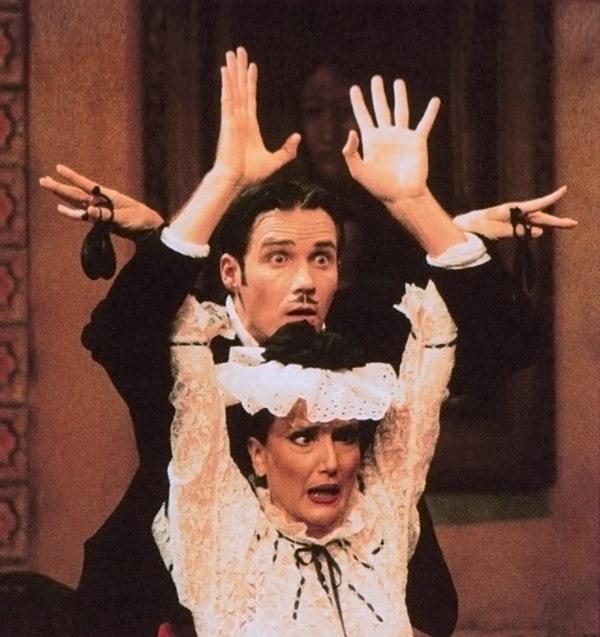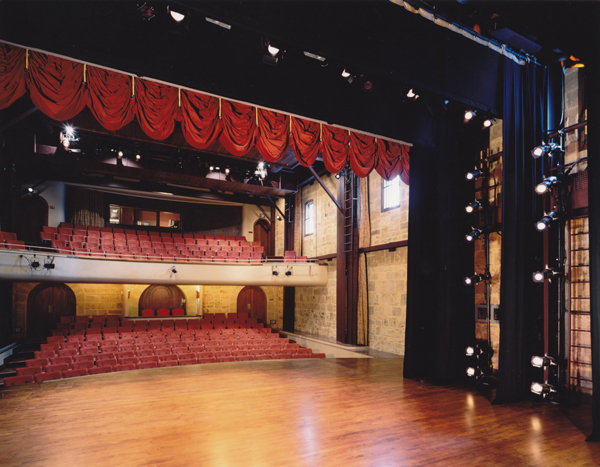To enlarge, click
on below image

A Magnificent Tapestry
Our fine arts program embodies voice, dance, music and costume, backed up by stage sets, lighting, sound and video production. Together, these art forms are blended to depict the powerful drama (and humor) of our life. During the special moments of an opera, we can realize those highest aspirations not present in our otherwise ordinary existence.

The Jarvis Conservatory
Auditorium and Stage
People marvel about what they imagine to be my life-long passion for the Zarzuela (Spanish Musical Theatre) and how I finally created the Jarvis Conservatory to carry out this passion. Yet just the opposite is the case. When we decided on using the old stone Matthews Winery building for our Conservatory, we realized that the existing stone walls would limit our theater to about 220 seats. (Luckily this turned out to be just the right size for the present Napa population base of only 70,000. You can build big theaters but somebody has to be around to attend them.) The genre of the Zarzuela seemed ideal for a small theater. We had seen some lovely Zarzuela productions in Spain. They use operatic singers but fewer singers than needed in the Italian Grand Opera. The Zarzuelas are also orchestrated for smaller orchestras, such as those that can fit in our 30 musician orchestra pit. Best of all, this classic art form of Zarzuela is noticeably absent in the United States and there is a huge body of first-class literature we can draw upon to create a real niche for our new Conservatory.
So the theater came first, then came the Zarzuela, and then also the French Baroque dance, well suited for a small theater. To expand our audience, we developed the artistry and technology to produce state-of-the-art videos of our productions. Those videos would be seen over the T.V. and in other ways by many thousand fold as many people as our theater would hold; so our theater size wasn’t a limitation after all.
Once I became absorbed in research on the Zarzuelas I discovered a much larger world of music literature than I had ever imagined. Of the 10,000 Zarzuelas that are indexed, there are 1,000 or so still considered in the available literature; of those, some 200 are active in today’s production. All these are “classics” in that they have stood the test of time; the fact that they are still around shows them to have a universal story and music. My challenge after getting this far was to narrow down to a couple of dozen that I could reasonably expect to do soon, and then to translate them into English and adapt the libretto for our American audience. Whereas Italian opera deals with stories of Kings and Princes, the Zarzuela builds its stories around ordinary people with the same ordinary emotions we all have. The challenge is to successfully portray these emotions with dialog and beautiful music to tell a worthwhile story.
An interesting by-product of all my research and translation was a nice insight into Spanish culture, the same culture that was propagated to all Hispanic America. The founders of a Spanish Zarzuela company, Ases Líricos in Madrid became close friends and when they retired from regular Zarzuela productions they sold us their entire wardrobe, including costumes identified for 14 different Zarzuelas.
Through Carlos Bofil of Ases Líricos we met Antonio Apruzzese, the last of the organillo makers. He had learned the art of making organillos from his father and carried on this grand tradition. The then president, General Franco, was so taken with the traditional Spanish craftsmanship that went into these hand cranked music makers that over the years he bought and gave away at least five organillos that we know of to visiting heads of state.We also acquired a small organillo from Apruzzese on one of our visits to Madrid. When organillo-maker Apruzzese died in 1996, his widow called us from Spain to tell us that since some of the previously not-for-sale organillos must be disposed of, we should come to Madrid immediately. That we did and were able to acquire probably the two finest organillos Apruzzese had ever made. These are invaluable for use in Zarzuela productions (www.jarvisconservatory.com), where this traditional street instrument often appears.
A real payoff for our conservatory work is to hear that our singers are going on to greater successes in their careers.

Home
| Grandfather | Father |
Myself | Main Index
![]()

